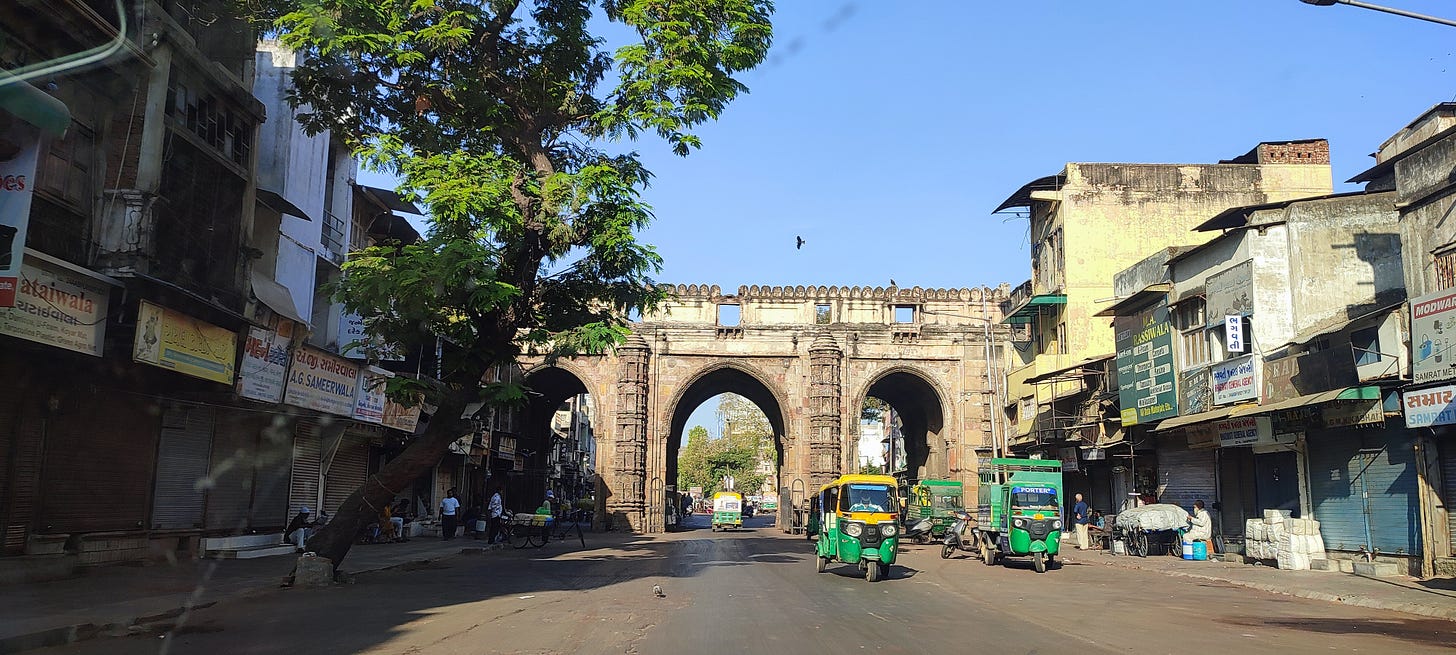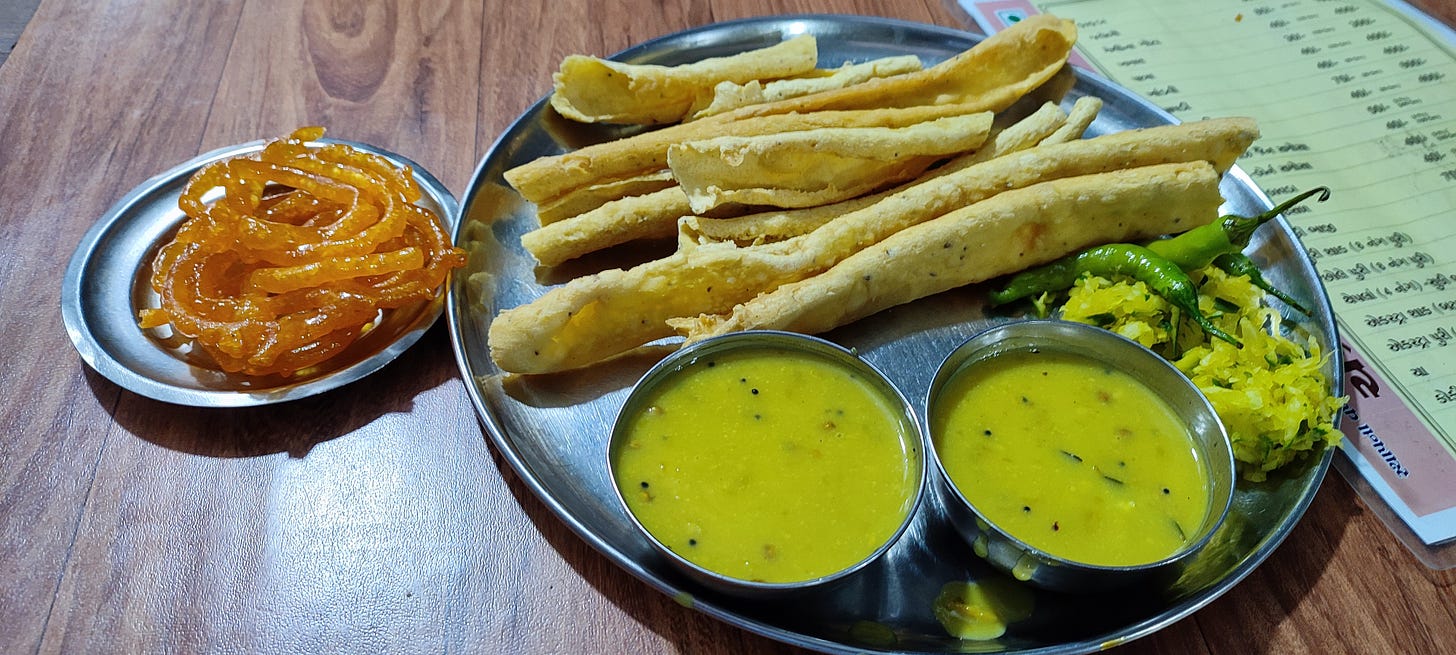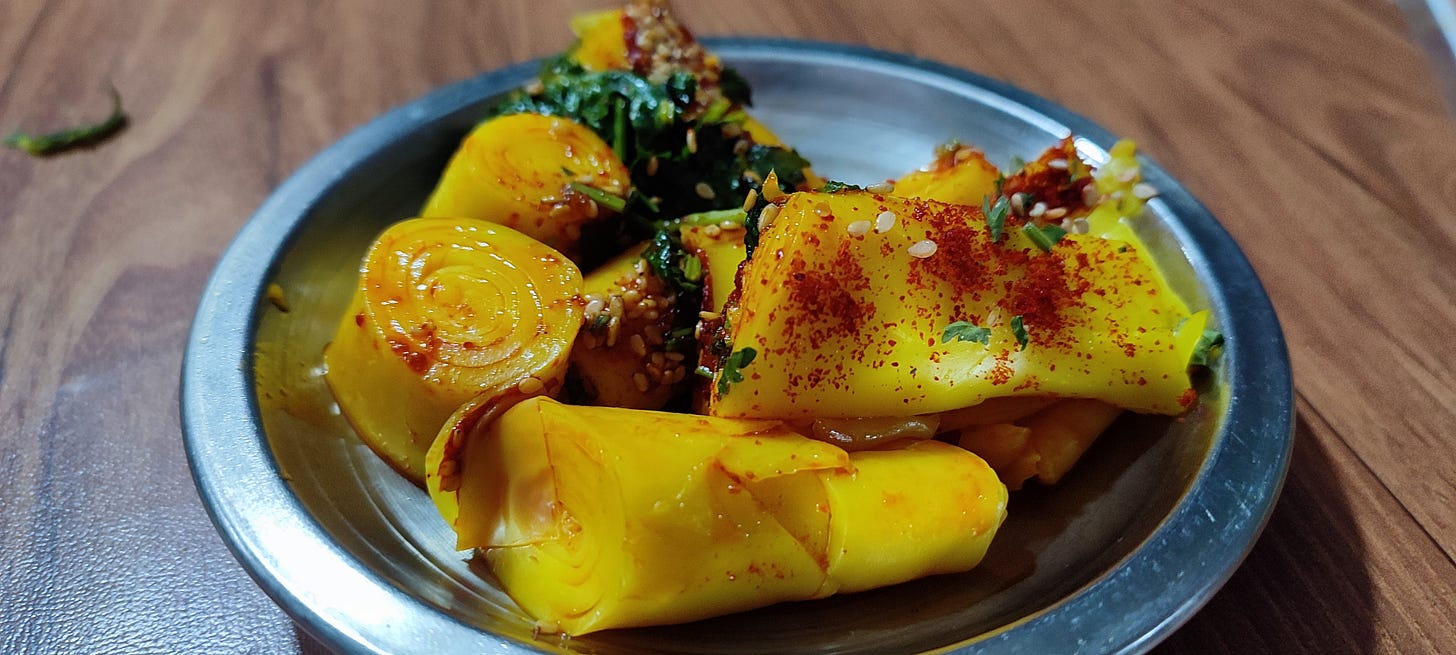Chandravilas, Ahmedabad: Cultural Ramblings from a 125-year old Fafda-Jalebi shop
I have wandered through the gullies of the walled city of Amdavad since I was a wee little child. Both sides of my paternal family have traditional connections to the tiny pols that weave together the city’s land area in a tight, dense, interlocking fashion. Trips to Gheekantha and Manek Chowk were common, and one thing that would always stand out to me was the busyness of the old city compared to its newer counterpart. The small streets are home to an economy largely composed of cart-yielding vendors, traditional manufacturers and wholesale retailers, and every square inch of the city would be jam-packed with people hustling their way through the day, on foot, on a motorcycle, pushing a street-cart. There is no time to stop and admire the city’s monuments around you, and it would be difficult to do so for unemployed musafirs like me anyways, as the constant streams of movement from all sides makes it impossible for one to stand at ease and admire the beauty of the Teen Darwaza or the mosques or remnants of forts that seamlessly merge with newer construction. You are always pushed forward, and if you are not actively moving with the crowd, you will be pushed backwards, to the left, to the right, up in the air, underground, and to any other dimension that physicists are capable of measuring.
Last month, an old school friend and I decided to meet for the first time in 5 years over breakfast, and we decided to hit up one of the Old City’s most popular spots - Chandravilas on Gandhi Road, one of the best examples of the city’s living heritage. This shop, founded at the turn of the century in the year 1900, is not merely one of those old, dilapidated shops that you find in every city, reputed to be the best in its respective offerings. Chandravilas has had significant cultural contributions to the traditions and food culture of not just Amdavad, but Gujarat as a whole. It is believed that the tradition of eating Fafda-Jalebi on Dusshera was popularised by them around a hundred years ago - a tradition that is now so wide-spread across the state that it is not uncommon to see customers line up outside sweet shops as much as eight hours before breakfast starts. They’re also said to have invented the Gujarati Thali - which is an absolutely insane legacy to have associated with your restaurant. The ubiquity of the Gujarati Thali is not unknown to people who have visited the region, and to think that it all started merely a century ago from a restaurant in Old Amdavad is insane to think of. This is on par with a shop being able to boast that they invented the Chhole Bhatuure, the Samosa, the Biryani or the Fuchka. There exist giants amongst men, and Chandravilas is the food equivalent of a Charizard.
We went there for breakfast - a time when the City is asleep; the shutters of shops are closed, the pot-bellied businessmen are fast asleep and the labourers are preparing themselves for a day of back-breaking manual work. This was the first time in years that I saw the major arteries of the City free of human movement. The streets were empty and did not feel cramped, there were no markets in front of the Teen Darwaza to obstruct my view of it, and the cacophony of the retailers was replaced by the morning song of the koyal. The city was devoid of its hustle and bustle that gives it life, but the emptiness that followed gave it a wonderful charm that is perhaps only witnessed for a few daylight hours everyday. We ordered their Fafda-Jalebi and Khandwi, and skipped the Gujarati Thali for now.
(In case I have the Thali, or any other item of theirs in the near future, I will update this blog with my review of it as well.)
The Fafda-Jalebi was incredible. Besan flour with a sprinkle of black pepper powder that is rolled and flattened by hand in an incredibly skillful process, before being deep-fried and served with a side of a raw papaya chutney, a besan-based kadhi, deep-fried de-seeded green chillies, and piping hot Jalebi. The fafda is flat, yet, rounded and open from the top, and doubly acts as a spoon that can be used to scoop up the two chutneys served with it. Chandravilas continues to make their fafdas the old way – being extraordinarily longer than its competitors, and quite thin but not excessively soft or breakable; just the right thickness and texture that you need from a quality fafda. Barring the jalebi, which was fairly sweet, the taste of everything served was quite simple, mild, and rustic, and the green chillies weren’t spicy at all, which is a welcome sign. The taste of black pepper in the fafda was barely noticeable, and the raw papaya chutney was simple and not too intense. For some people, it would be right up their alley, but I prefer my fafdas to have a bit of a kick from the pepper to go with the simple flavours of the besan, and the papaya side to be a bit more flavourful as the slight sourness acts as a good contrast to the slightly-spicy-but-mostly-bland fafda.
The Khandvi, rolled besan layers flavoured with tempered white sesame seeds, coriander leaves and fried green chillies, was as soft as a touch-me-not and fell apart in my hands as soon as a road constructed by the BMC does. Good Khandvi usually has a slightly sour undertaste to it, thanks to buttermilk being used during the cooking process, but this wasn’t so at all, instead, being on the spicier side thanks to a generous sprinkle of red chilli powder (and other assorted masalas) on the layers of the Khandvi. This is not a complaint; merely an observation, and the Khandvi was an excellent addition to our breakfast platter.
Perhaps I was too obsessed with a narrow understanding of what “heritage” entails in the initial paragraphs of this piece. Of course, the ability to admire the great details of medieval structures at peace, whether it be grand monuments, old mosques or dilapidated forts, is an important part of appreciating a city’s heritage. And experiencing the Teen Darwaza, arguably the second-most iconic symbol of the city, at an hour sans mayhem was a beautiful experience that I will never forget for the rest of my life. But heritage is also the people, the long-standing institutions, the markets, the hustle and bustle, the commodities traded and manufactured. Modern culture is mixed with the old - whether it be a 700-year old tomb complex of a Queen being repurposed by locals as a space where oxidised jewellery and mukhvaas is sold, or an institution as old as Chandravilas adopting modern aspects of Gujarati fusion food culture by including the cheese dosa and gwalior dosa on its menu. The commotion that I noticed as a child was not merely an obstruction to observing heritage, but heritage in itself, molded and shaped by the cultural institutions and economic realities of modern day. The sign displayed on Chandravilas’ entrance proudly displays celebrities that swear by its fare, from political leaders like Narendra Modi and MK Gandhi to Bollywood actors like the Big B and Raj Kapoor, with huge text plastered over the top, saying that their legacy was built by the VIPs who’ve visited it over the years. Perhaps, this is irrelevant. It is a disservice to the legacy of Chandravilas to say that a few VIPs are what made the place what it is today. The true legacy of the institution is in it having revolutionised Gujarati cuisine for the remainder of eternity, and being able to maintain relevance despite being older than laminated glass and penicilin.
But back to the review. This place is still a classic, but despite the century (and more!) of history that is associated with this establishment, I can’t say that this is the *best* place I’ve had fafda-jalebi at. In fact, I don’t have a definitive answer as to what the best place for Gujarati breakfast in the city is – in part because I feel the quality of food in the city is pretty damn good regardless of locality, in part because my explorations when it comes to food in Amdavad are quite limited (there are three banger breakfast spots just opposite my house, not to mention food cooked at home, so I don’t really have an incentive to explore the city!). My suggestion to people who visit the city is always to just have some breakfast at a popular sweet shop close to the hotel they’re staying at, and it usually elicits a positive review from whatever spot they decide to go to. At the same time, it cannot be denied that Chandravilas has had an incredible impact on the city’s food culture, and is one of the few pre-independence eateries of the city that still stand strong, so if you have some time to kill, and don’t mind making an early-morning trek to Gandhi Road, the Fafda that has fuelled the city for the past 125 years will be waiting for you.
Recommendations:
Fafda (8/10), Jalebi (9.5/10), Khandwi (8.25/10)
Location:
Gandhi Rd, Near Ratan Pol, Old City, Tankshal, Khadia, Ahmedabad, Gujarat 380001






